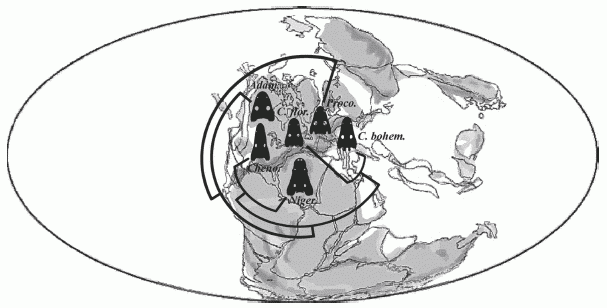|
|
Temnospondyli |
| The Vertebrates |
Edopoidea |
Edopoidea
Taxa on this Page
- Adamanterpeton X
- Chenoprosopus X
- Cochleosauridae X
- Cochleosaurinae X
- Cochleosaurus X
- Edopoidea X
- Edops X
- Nigerpeton X
- Procochleosaurus X
The Edopoids
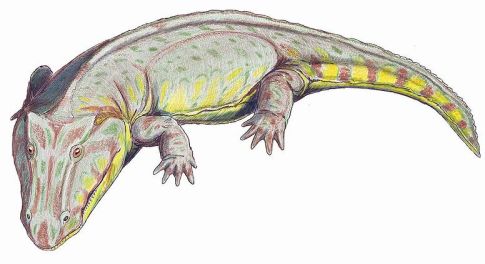
Edops craigi, life reconstruction, by Dmitry Bogdanov, 2007 (Wikipedia)
From Darren Naish's blog Tetrapod Zoology: Temnospondyls the early years (part I) ( June 29, 2007 ):
Often regarded as the most primitive temnospondyl group is the Edopoidea (previously known as Edopsoidea). Unlike more advanced kinds they exhibited an archaic pattern of palatal bones, and still possessed various additional bones at the back of the skull. Edopoids also had particularly big premaxillae (the bones that form the tip of the snout) and proportionally small external nostrils. Within the clade, the most basal member seems to be Edops from the Early Permian of the USA, a broad-skulled animal with large palatal teeth. It was fairly big, at 2 m in length. Fragmentary remains from the Viséan of Scotland appear to come from Edops or a close relative and hence predate the type Edops material of the Permian.
Cochleosaurids were long-snouted edopoids, ranging in length from c. 30 cm to perhaps 3 meyers, known from swamp and lacustrine habitats of Nova Scotia, Ohio, the Czech Republic, Ireland and Africa. Lateral line canals are absent (with one exception: read on), so they are thought to have been mostly terrestrial (although it is known that they produced aquatic gilled larvae). While their skulls are decorated by a sculpturing of pits and furrows, a distinctive feature of the group is that a zone along the skull midline is only lightly sculptured (Sequeira 1996, 2004, Milner & Sequeira 1998). Cochleosaurids might have been amphibious predators and they have typically been imagined as rather crocodile-like in basic lifestyle. The broader-skulled forms were perhaps similar to Edops in being amphibious ambush predators of fish and smaller tetrapods, while some of the more narrow-snouted cochleosaurids, like the cochleosaurine Chenoprosopus milleri [above], may have foraged on land for arthropods and small tetrapods. However, even Edops is interpreted as terrestrial by some workers (Schoch 2001, p. 341).
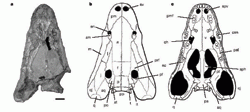 Nigerpeton, the only African cochleosaurid, is closely related to Chenoprosopus but is in many ways a highly unusual member of the group. It was gigantic compared to some of its relatives, with a long, flattened skull 45-56 cm long, and its lateral line system contrasts with their absence in other edopoids. Like many temnospondyls, Nigerpeton possessed particularly large fang-like palatal teeth as well as enlarged teeth in the lower jaw, but the degree of heterodonty it possessed is extraordinary: the teeth at its premaxillary tips were large, and tooth size then declined posteriorly before increasing again in the maxilla, before decreasing again further posteriorly. Particularly big fangs - bigger than those lining the jaws - were present in patches on parts of the palate, while huge fangs near the lower jaw tip fitted through special openings in the skull roof when the mouth was closed [in the adjacent image, the big holes near the snout-tip are not the nostrils (those are much further back), but are instead the openings for the fangs of the lower jaw]. Protruding lower jaw teeth are also seen in a much later group of temnospondyls, the mastodonsauroids (and are also present in some living crocodilians). These specialized teeth suggest that Nigerpeton was an effective carnivore, presumably capable of grabbing large tetrapods (Steyer et al. 2006). While other cochleosaurids are Carboniferous and from the Northern Hemisphere, Nigerpeton is unusual in being from the Late Permian of Niger. Discovered alongside captorhinids, pareiasaurs, and the late-surviving basal temnospondyl Saharastega, Nigerpeton provides further support for the idea that Late Permian west African was home to a strongly endemic fauna (Sidor et al. 2005, Steyer et al. 2006).
Nigerpeton, the only African cochleosaurid, is closely related to Chenoprosopus but is in many ways a highly unusual member of the group. It was gigantic compared to some of its relatives, with a long, flattened skull 45-56 cm long, and its lateral line system contrasts with their absence in other edopoids. Like many temnospondyls, Nigerpeton possessed particularly large fang-like palatal teeth as well as enlarged teeth in the lower jaw, but the degree of heterodonty it possessed is extraordinary: the teeth at its premaxillary tips were large, and tooth size then declined posteriorly before increasing again in the maxilla, before decreasing again further posteriorly. Particularly big fangs - bigger than those lining the jaws - were present in patches on parts of the palate, while huge fangs near the lower jaw tip fitted through special openings in the skull roof when the mouth was closed [in the adjacent image, the big holes near the snout-tip are not the nostrils (those are much further back), but are instead the openings for the fangs of the lower jaw]. Protruding lower jaw teeth are also seen in a much later group of temnospondyls, the mastodonsauroids (and are also present in some living crocodilians). These specialized teeth suggest that Nigerpeton was an effective carnivore, presumably capable of grabbing large tetrapods (Steyer et al. 2006). While other cochleosaurids are Carboniferous and from the Northern Hemisphere, Nigerpeton is unusual in being from the Late Permian of Niger. Discovered alongside captorhinids, pareiasaurs, and the late-surviving basal temnospondyl Saharastega, Nigerpeton provides further support for the idea that Late Permian west African was home to a strongly endemic fauna (Sidor et al. 2005, Steyer et al. 2006).
Edopoids - perhaps the most basal temnospondyl clade we know of - therefore included mid-sized terrestrial and amphibious taxa as well as late-surviving big-toothed macropredators.
Copyright Darren Naish © 2007, republished with permission
Geographical distribution
The edopoids and their relatives were typical elements of the tropical and mostly equatorial Euramerican Coal Swamp biome (the "Edaphosaur-Nectridean faunal province" of Milner 1993). The distribution and relationships of some representative taxa are shown on the map at the right.
During the post-Asselian early Permian, the edopoids dissapeared from the known regions, although other Permocarboniferous tetrapods continued to flourish. The discovery of an edopoid (Nigerpeton) and edopoid-cousin (Saharastega) from the late Permian of North-West Africa (equatorial Gondwana) shows that these animals continued to exist and flourish right up till the end of the Permian.
They were part of a unique province made up of highly endemic fauna, that included Carboniferous-grade basal temnospondyls, Permian grade Captorhinids, and late Permian Parierasaurs. Therapsids seem to be rare or absent. It may be that there were geographical factors which kept these animals isolated from the rest of the world.
These animals inhabited the valleys of an equatorial mountain chain; the Central Pangean Mountains (Scotese, 2001) that was the result of the collision of Laurussia with Gondwana. This had an estimated altitude of more than 2000 m at the end of the Permian. It seems that the edopoids (and relatives) crossed the Central Pangean Mountains at least twice during their evolutionary history (Steyer et al 2006 p.26).
The edopoidian grade temnospondyls do not appear to have expanded their geographic range into southern Gondwana, despite the milder conditions of the high latitudes following the retreat of the glaciers. Perhaps this was due to competition from other temnospondyls, or it may simply have been geographical isolation
MAK090710
Descriptions
 Adamanterpeton ohioensis:
Adamanterpeton ohioensis:
Late Carboniferous (Middle Pennsylvanian - Moscovian) of Linton, Ohio
Phylogeny: Cochleosauridae : Procochleosaurus + (Cochleosaurinae + *)
Reference: Milner & Sequeira 1998
Illustration: From cladogram in Steyer et al 2006 p.25
MAK090710
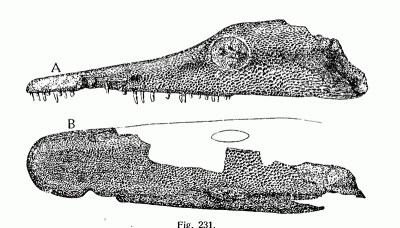 Chenoprosopus :
Chenoprosopus :
Phylogeny: Cochleosaurinae: Cochleosaurus + (Nigerpeton + *).
Illustration: Wikipedia (Mehl, 1913)
MAK090710
 Chenoprosopus lewisi :
Chenoprosopus lewisi :
Phylogeny: Chenoprosopus: C. milleri + *.
Characters: short snout
Illustration: From cladogram in Steyer et al 2006 p.25
MAK090710
 Chenoprosopus milleri:
Chenoprosopus milleri:
Permo-Carboniferous (Gzhelian to Asselian) of North America (Abo Formation of New Mexico; Land-Coyotean vertebrate faunachron, includes Permo-Carboniferous boundary (Lucas, 2006)
Phylogeny: Chenoprosopus: C. lewisi + *.
Characters: Long snout
Reference: Mehl, 1913
Illustration: From cladogram in Steyer et al 2006 p.25
MAK090710
 Cochleosauridae: Cochleosaurus, Chenoprosopus, Nigerpeton.
Cochleosauridae: Cochleosaurus, Chenoprosopus, Nigerpeton.
Range: Late Carboniferous of Europe and North America to Late Permian of North Africa.
Phylogeny: Edopoidea: Edops + * : Procochleosaurus + (Adamanterpeton + Cochleosaurinae)
Introduction: This group is best known from Cochleosaurus bohemicus Fritsch 1885), from the Late Carboniferous of Central Europe (equatorial Pangea). A reconstruction is shown at right from Milner 1980). Cochleosaurus was a medium-sized (120-160 cm) temnospondyl with a flattened skull of up to 16 cm. It lived as a fresh water aquatic predator of the "East Edaphosaurid-Nectridean Empire." Numerous specimens of various growth stages are known, and it is believed that Cochleosaurus was a common predator in its size range.
Characters: $ depressed areas with subdued sculpture between parallel sculpture ridges on the skull table; $ relatively elongate prechoanal region of the vomer; $ ectopterygoid separating from the subtemporal fossa.
Links: CARBONÍFERO PENSILVANIANO; Phylogeny and Apomorphies of Temnospondyls
References: Milner (1980). 020412
Cochleosaurus :
Range: Bashkirian to Moscovian of Europe and North America.
Phylogeny: Cochleosaurinae: (Chenoprosopus + Nigerpeton) + * : C. bohemicus + C. florensis.
 Cochleosaurus bohemicus:
Cochleosaurus bohemicus:
Late Carboniferous (Westphalian D - Late Moscovian) of Nýřany, Czech Republic
Phylogeny: Cochleosaurus: C. florensis + *.
Illustration: From cladogram in Steyer et al 2006 p.25
MAK090710
 Cochleosaurus florensis:
Cochleosaurus florensis:
Carboniferous (Middle Pennsylvanian - Late Bashkirian) of Joggins, Novia Scotia
Phylogeny: Cochleosaurus: C. bohemicus + *.
Reference: Rieppel, 1980
Illustration: From cladogram in Steyer et al 2006 p.25
MAK090710
Cochleosaurinae: Cochleosaurus + Chenoprosopus (node-based taxon).
Range: Late Carboniferous of Europe and North America to Late Permian of North Africa.
Phylogeny: Cochleosauridae: Procochleosaurus + (Adamanterpeton + * ): Cochleosaurus + (Chenoprosopus + Nigerpeton).
Characters: $ depression in vomer anterior to choana; $ elongate and narrow sphenethmoid; pineal foramen closed in skulls greater than 120 mm in midline length (convergent with Saharastega).
Reference: Steyer et al 2006 p.18
MAK090710
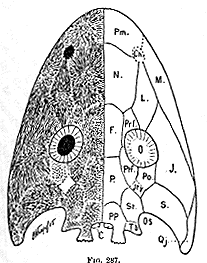 Edopoidea: Cochleosaurus, Edops.
Edopoidea: Cochleosaurus, Edops.
$ marginally elongate premaxilla; retain intertemporal and moveable articulation between base of braincase and pterygoid; squamosal embayment supported ventrally by the quadratojugal and a quadrate process.
Image: Cochleosaurus skull.
Links: Dendrerpeton and Joggins, Nova Scotia (Best on the Web); Air Breathers of the Coal Period; The Joggins Fossil Cliffs; Phylogeny and Apomorphies of Temnospondyls; Historický vývoj Czech). ATW030219
Edops:
Phylogeny: Edopoidea: Cochleosauridae + *.
Characters: marginal dentition with pseudocanine peaking with maxillary swellings above the peaks.
Links: Les quatre autres extinctions de masse; Basal Temnospondyli; Phylogeny and Apomorphies of Temnospondyls. 020412
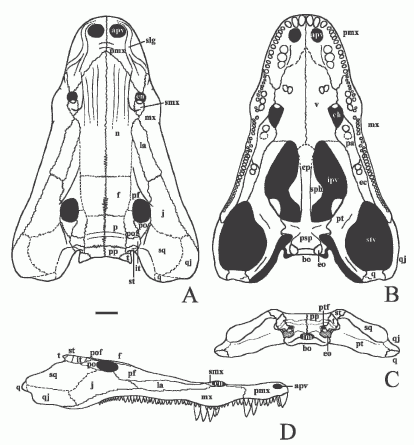
Reconstruction of the skull of Nigerpeton in dorsal (A), palatal (B), occipital (C), and lateral (D) views.. Scale bar is 5 cm. Steyer et al 2006 p.23
|
Nigerpeton :
Phylogeny: Cochleosaurinae: Cochleosaurus + (Chenoprosopus + *).
Characters: orbits positioned far back resulting in very elongated preorbital region (~70% of total skull length); tip of snout pierced by mandibular fangs; supratemporal bone highly reduced; maxilla bearing two or three medially positioned fangs at level of maxillary swelling; high occipital and posterior regions of skull; lateral-line system in adult. (Steyer et al 2006 p.19)
Comments: An aquatic or semi-aquatic form, with a long alligator-like snout, and sensory line canals for detecting movement in murky water. It probably lived in river and lake systems in the equatorial Gondwanan mountains.
Reference: Steyer et al 2006
Illustration: Reconstruction of skull of Nigerpeton ricqlesi Sidor et al., 2005 in dorsal (A), palatal (B), occipital (C), and lateral (D) views. Scale bar equals 5 cm. From Steyer et al 2006 p.23
MAK090710
 Procochleosaurus jarrowensis:
Procochleosaurus jarrowensis:
Middle Carboniferous (Bashkirian) of Jarrow, Ireland
Phylogeny: Cochleosauridae : (Adamanterpeton + Cochleosaurinae) + *.
Reference: Sequeira 1996
Comments: The oldest known and also the most primitive cochleosaurid
Illustration: From cladogram in Steyer et al 2006 p.25
MAK090710
 Nigerpeton, the only African cochleosaurid, is closely related to Chenoprosopus but is in many ways a highly unusual member of the group. It was gigantic compared to some of its relatives, with a long, flattened skull 45-56 cm long, and its lateral line system contrasts with their absence in other edopoids. Like many temnospondyls, Nigerpeton possessed particularly large fang-like palatal teeth as well as enlarged teeth in the lower jaw, but the degree of heterodonty it possessed is extraordinary: the teeth at its premaxillary tips were large, and tooth size then declined posteriorly before increasing again in the maxilla, before decreasing again further posteriorly. Particularly big fangs - bigger than those lining the jaws - were present in patches on parts of the palate, while huge fangs near the lower jaw tip fitted through special openings in the skull roof when the mouth was closed [in the adjacent image, the big holes near the snout-tip are not the nostrils (those are much further back), but are instead the openings for the fangs of the lower jaw]. Protruding lower jaw teeth are also seen in a much later group of temnospondyls, the mastodonsauroids (and are also present in some living crocodilians). These specialized teeth suggest that Nigerpeton was an effective carnivore, presumably capable of grabbing large tetrapods (Steyer et al. 2006). While other cochleosaurids are Carboniferous and from the Northern Hemisphere, Nigerpeton is unusual in being from the Late Permian of Niger. Discovered alongside captorhinids, pareiasaurs, and the late-surviving basal temnospondyl Saharastega, Nigerpeton provides further support for the idea that Late Permian west African was home to a strongly endemic fauna (Sidor et al. 2005, Steyer et al. 2006).
Nigerpeton, the only African cochleosaurid, is closely related to Chenoprosopus but is in many ways a highly unusual member of the group. It was gigantic compared to some of its relatives, with a long, flattened skull 45-56 cm long, and its lateral line system contrasts with their absence in other edopoids. Like many temnospondyls, Nigerpeton possessed particularly large fang-like palatal teeth as well as enlarged teeth in the lower jaw, but the degree of heterodonty it possessed is extraordinary: the teeth at its premaxillary tips were large, and tooth size then declined posteriorly before increasing again in the maxilla, before decreasing again further posteriorly. Particularly big fangs - bigger than those lining the jaws - were present in patches on parts of the palate, while huge fangs near the lower jaw tip fitted through special openings in the skull roof when the mouth was closed [in the adjacent image, the big holes near the snout-tip are not the nostrils (those are much further back), but are instead the openings for the fangs of the lower jaw]. Protruding lower jaw teeth are also seen in a much later group of temnospondyls, the mastodonsauroids (and are also present in some living crocodilians). These specialized teeth suggest that Nigerpeton was an effective carnivore, presumably capable of grabbing large tetrapods (Steyer et al. 2006). While other cochleosaurids are Carboniferous and from the Northern Hemisphere, Nigerpeton is unusual in being from the Late Permian of Niger. Discovered alongside captorhinids, pareiasaurs, and the late-surviving basal temnospondyl Saharastega, Nigerpeton provides further support for the idea that Late Permian west African was home to a strongly endemic fauna (Sidor et al. 2005, Steyer et al. 2006).
